
17 minute read
ORIGINAL PAPER Luciano Giuliani (1928-1994): Great master and founding father of modern Italian Urology
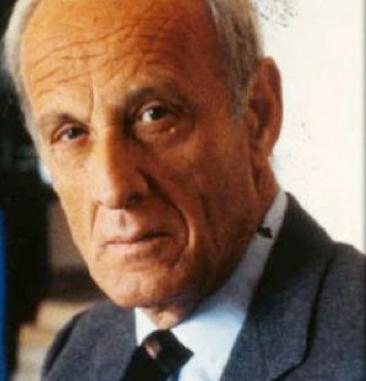
Mariano Martini 1, 2 , Giuseppe Martorana 3
1 Department of Health Sciences, University of Genoa, Genoa, Italy;
2 UNESCO Chair Anthropology of Health Biosphere and Healing System, University of Genoa, Genoa, Italy;
3 University of Bologna, Bologna, Italy
Summary
Luciano Giuliani was born near Arezzo, in Tuscany (Italy) in 1928 After taking his Degree cum Laude in Medicine and Surgery at the University of Florence in 1951, he became a voluntary assistant at the Institute of General Clinical Surgery and Surgical Therapy. He then took a diploma in Urology and General Surgery, having demonstrated his great technical and surgical ability, and was subsequently appointed assistant in charge and then extraordinary assistant. Endowed with uncommon surgical skills and a forceful personality, Giuliani tirelessly carried out his clinical and surgical activity, covering several roles and rapidly earning profound esteem and recognition in the field of urology As a pupil of the great luminary of Italian surgery, Ulrico Bracci, Dr Giuliani keenly followed his master, embracing his teachings and surgical techniques, until 1969, when he was appointed to run the 2nd Urology Division at San Martino Hospital in Genoa He subsequently took up the chair of Urology at the University of Genoa and became Director of the Specialty School in Urology Within a few years, he earned a solid reputation both nationally and internationally through his innovative surgical techniques He also gave considerable impetus to the Genoese School of Urology, reaching the highest echelons of the Italian and European Societies of Urology At the beginning of the 1990s, he designed and founded a new urology clinic in Genoa; this imposing, avant-garde building was subdivided into four floors and equipped with 80 beds. In July 1994, he won the prestigious “Willy Grégoir Medal”, an accolade awarded to eminent personalities in European urology. In August of the same year, he died in the Institute that he himself had created at San Martino Hospital in Genoa.
KEY WORDS: Luciano Giuliani; History of Medicine; History of Urology; Italian Urology; Genoese Urology School
Submitted 22 March 2023; Accepted 23 March 2023
LUCIANO GIULIANI: THE FIRST STEPS
Dr Luciano Giuliani was bor n in Paindiscò (Arezzo) on 3 July 1928 (Figure 1)
Having matriculated at the Faculty of Medicine of the University of Florence in the academic year 1945-46, he enthusiastically and assiduously devoted himself to his studies In the years 1949-50 and 1950-51, he regularly frequented the departments and the laboratories of the Surgical Clinic as a student inter n
On 25 July 1951, at the University of Florence, he took his
Degree in Medicine and Surgery, having discussed an experimental thesis entitled “Intracardiac pressure variations after interruption of the inferior caval circulation” and ear ning top marks: 110/110 with distinction (1)
- Endowed with great talent, Giuliani was appointed voluntary Assistant at the Institute of General Clinical Surgery and Surgical Therapy of the University of Florence a few months later, on 1 November 1951 He immediately became known for his ability and diligence in carrying out his activities and for his outstanding skills, and his position was confirmed until 1954 In the period between 15 January 1952 and 31 May 1953, he carried out his obligatory military service; having achieved first place in his course (out of 302 candidates) (2) in the final examinations of the 10th Course for Additional Trainee Medical Officers, he was appointed Medical Officer with the rank of Second Lieutenant (3)
Subsequently, Giuliani first served as an Assistant at the Institute of War Traumatology and Surgery of the School of Military Health in Florence from 15 June 1952 to 15 June 1953 One of the first publications of his long career was “L’ibernazione” (“Hibernation”), which was published in the Gior nale di Medicina Militare (Jour nal of Military Medicine) in 1953 (4) In it, he outlined the biological, physiological and clinical bases of the practice of hibernation and offered some considerations regarding the purposes, indications and limitations of its application, particularly in the field of surgery (Figure 2) On 1 November 1954, Giuliani continued his career at the Surgical Clinic of the University of Florence, where he
Figure 2
S Ten Med Dott remarkable tenacity and determination, were evident right from the first years of his training Indeed, during his military service, he dealt with military traumatology and surgery from both a theoretical and practical standpoint, without ever interrupting his university activities Moreover, for several years, and consistently until 1956, he served as an assistant surgeon at the Ospedale Civile di Empoli during the summer closure of the University clinics, which enabled him to “stay on form” and to hone his surgical skills even during the summer period!
L. Giuliani. L’ibernazione Extract of Giornale di Medicina Militare (Journal of Military Medicine).
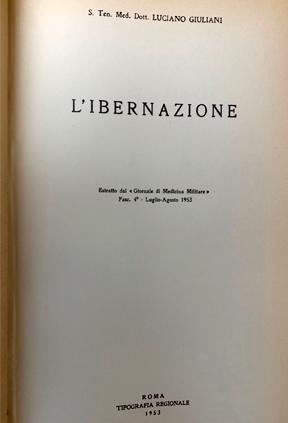
In the early period of his career, Giuliani actively devoted himself to the various branches of surgery, acquiring extensive knowledge of thoracic, urological, orthopaedic, gynaecological and obstetric surgery, in addition to general surgery Moreover, in 1956, when still academically very young (28 years old), he was given responsibility for the practical training in Clinical Urology of sixth-year students at the University of Florence, where he subsequently taught the following subjects at the Specialty School in Urology:
- functional diagnostics in urology (1st year);
- functional pathology of the excretory pathway was appointed “Extraordinary Assistant” , a position that he held until 1 November 1956, when he moved to the newly-founded Urology Clinic
During this period, Giuliani also took a Specialty Diploma in Urology at the University of Pisa (18 July 1955), achieving a mark of 70/70 (5)
Following the establishment of the new Urology Clinic of the University of Florence in 1956, Giuliani was immediately appointed Extraordinary Assistant The following year (1957), he further consolidated his training by taking a Specialty Diploma in General Surgery, achieving the top mark of 70 with distinction
The year 1957 was a particularly important one for Dr Giuliani; in addition to ear ning the above-mentioned Specialty Diploma in General Surgery (29 July) with distinction, he was appointed for the academic year 1957/58 as Designated Assistant to the Chair of the Urology Clinic (6), a position that was confirmed for the years 1958/59, 1959/60 and 1960/61
These were fundamental years and constituted the foundations on which he would later build his long and fruitful academic pathway in the field of urology
LUCIANO GIULIANI: A VERSATILE SURGEON AND A YOUNG ACADEMIC
On 18 April 1958, following a public competition, Giuliani qualified for the position of Ordinary Assistant to the Chair of Urology of the University of Florence The following month, however, he interrupted this tenure in order to be reconfirmed Extraordinary Assistant His title of Extraordinary Assistant was also confirmed for the academic year 1958-59
Dr Giuliani carried out his clinical and surgical activities in a continuous manner: first during his service at the Surgical Clinic in Florence as an assistant in the various departments of general and thoracic surgery and then in the urology department Subsequently, he held the position of Head of Department with the function of “Vicechief” at the Urology Clinic Giuliani's temperament and versatility, coupled with his
During those years, Giuliani wrote several scientific articles Notable for its originality, methodological rigour and scientific impact, was “On the extra-hepatic biliary pathways” , published in 1954 in the jour nal “La Chirurgia Generale” (7) (Figure 3)
Figure 3. “On the extrahepatic biliary pathways” (1954)“La Chirurgia Generale” (General Surgery) in Rivista di Biologia
In it, the young author made innovative anatomical, physiological and pathophysiological observations (8) However, the young Giuliani was still fascinated by the urological activity carried out in the dedicated department and coordinated by Prof Bracci, Prof Fedeli's assistant; he therefore began to participate more closely in this work
For his part, Prof Bracci, with the encouragement and approval of his mentor Prof Fedeli, had long been oriented towards the entire field of urology, working first in the surgical clinic in Perugia and then, after 1947, in Florence
Indeed, after first qualifying to teach Surgical Pathology and Surgical Anatomy, he became a freelance teacher of Urology in 1942 Moreover, while still a young assistant, and a few years after following Prof Fedeli to Florence, he wrote a book on urological semiotics (1950) and introduced an innovative method regarding “access pathways in the surgery of the urinary apparatus” (which would be published in 1956)
In 1955 (the year in which Giuliani took his specialty diploma in Urology), Prof Bracci was chosen as one of the three winners (together with Prof Pavone in Palermo, and Prof Pisani in Milan) of the first national competitive examination for the post of Ordinary Prof of Urology
The following year, he was appointed Director of the Institute of Clinical Urology of the University of Florence, the first university chair of urology in Italy, and in 1957 the specialty school in Urology was instituted Thus began a new era for Florentine urology in particular, and also for Italian urology in general
Bracci brought to urology all his knowledge of general surgery, developing themes which albeit previously described and implemented had, for various reasons, never been widely adopted, e g the use of the intestine in urology Hitherto, the standard procedure had been ureterosigmoidostomy (USS); urinary infection was the most frequent cause of severe complications sometimes more “malignant” than neoplastic disease progression

This aspect soon became the principal theme to investigate (as is well described in Bracci's report, published in 1959 in Chirurgia Urologica) (Figure 4) teachings of their mentor In those years, the Urology Clinic of the University of Florence was made up of:
– ordinar y assistants with "vice-chief" responsibilities: Alfiero Costantini, Luciano Giuliani, Mario Polito, Mario Tacciuoli;
– o rd i n a r y a s s i s t a n t s a n d v o l u n t e e r s : Tu l l i o L o t t i , Francesco Micali, Nicola Cer ulli, Michelangelo Rizzo, Alessandro Basso, et al ; physicians from different specialties who collaborated with the Chair of Urology: Elia Vernaglione, Anna Martini (anaesthetists) Gianfranco Bruscagli (cardiologist) Bruno Fedi (pathologist) Imola Rossi (chemist) Giancarlo Masini (radiologist)
Among these, was Luciano Giuliani, who (as we have already mentioned above) became “extraordinary university assistant” at the newly founded Urology Clinic on 1st November 1957 (9)
Giuliani soon became one of Bracci's closest collaborators:
– from the surgical point of view: he was one of Bracci's favourite assistants in the operating theatre;
– from the teaching point of view: he was entrusted with the practical training in Clinical Urology of sixth year students at the University of Florence; from the scientific point of view: he immediately manifested his propensity for research; specifically, he supported his mentor and conducted important studies in experimental surgery and urodynamics of the urinary derivations (10, 11)
As the author of numerous publications of a clinical, radiological, pathological, surgical and experimental nature, generally in the field of urology, Dr Giuliani was awarded the prestigious “prize for scientific diligence” for the academic years 1956/57 and 1958/59 at the University of Florence Moreover, at the 32nd Congress of the Italian Society of Urology in September 1959, he received the “Premio Itala IV°” for the best urology publication of the year for his paper entitled: “Gastrocystoplasty: from the experimental idea to some practical considerations concerning plastic and replacement surgery of the bladder” (10)
From 1959 onwards, Dr Giuliani also worked systematically in the departments of general and thoracic surgery directed by his mentor Ulrico Bracci at the Sanatorium of the Anti-tuberculosis Consortium in Florence, were he was able to increase his surgical skills and his clinical experience (12)
T h e m a i n o b j e c t i v e w a s t o a b a n d o n t h e p re v i o u s approach, which involved the mixing of faeces and urine, and to create a reservoir that displayed the following characteristics: sufficient capacity to allow almost normal frequency of urination;
– in the filling phase, the patient could feel the stimulus and would be prompted to urinate;
– complete emptying and explorability;
– no negative impact on the upper urinary apparatus
As the rectal neo-bladder met these requirements, it was adopted, in its variants, for years
Bracci proved to be a great innovator and succeeded in promoting his discipline, bringing together a group of young physicians, who enthusiastically embraced the
Prof Ulrico Bracci was one of the great luminaries of 20th century Italian surgery and the founder of the first true Italian school of urology at the end of the 1950s in Florence and subsequently in Rome Prof Bracci played a fundamental role as an innovator and promoter of specialisation in urology, becoming a dominus and a point of reference for Italian urologists for over 30 years
After again winning the “prize for scientific diligence” (1959/60), in 1960 Giuliani deservedly obtained his qualification as untenured lecturer in Urology (Special Surgical Pathology and Clinical Propedeutics), achieving first place among the candidates
In the same year, he actively collaborated in the Italian Society of Urology's official report (Brescia-Bergamo) on “Surgery for renal hypertension” (Figure 5)
A year later, 1961, he took part in the report of the annual Congress on the “Surgical treatment of prostate cancer”
Figure 5.
Atti della Società italiana di UrologiaUrology's official report (Oberholtzer A, a cura di), XXXIII Congresso, Bergamo-Brescia, 13-16 Ottobre, 1960 the intestine in urology (13); – radical prostatectomy (14);
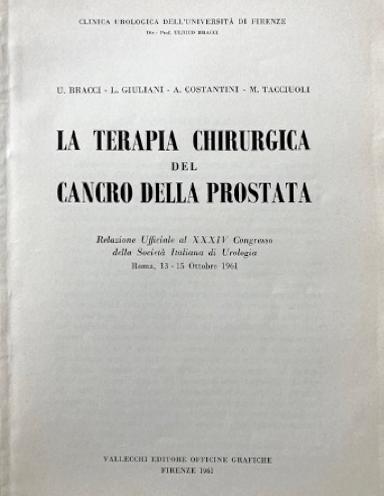
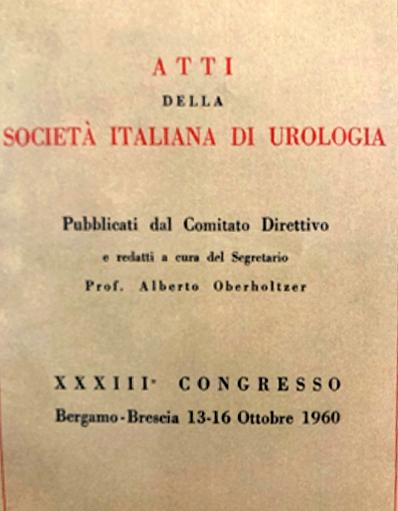
– pathways of access in the surgery of the urinary apparatus
All this involved demanding and innovative research work, all of which was designed and implemented during this fruitful Florentine period Subsequently, it was developed during Giuliani's Roman period Indeed, in 1963, Prof Bracci was called to Rome to take up the first official chair of urology in the history of the capital
This marked the beginning of the so-called “Roman School of Urology” , a development that had considerable impact on the history of Italian urology
The Urology Clinic in Florence was left under the direction of Alfiero Costantini, while Bracci was followed by his pupils Giuliani and Tacciuoli, who supported their master in his teaching Subsequently, Lotti, Micali and Polito also moved to Rome, followed later by Cerulli and Calderini and just the surgery of prostate cancer is another example of Prof Bracci's boost to “ more complex” urological surgery
This had previously been rarely undertaken, as the subtle course of the disease meant that the tumour was almost always discovered when it was no longer operable This was the first time in Italy that the issue of radical prostatectomy had been presented in such an organic, complete and didactic manner Thus, its anatomo-surgical foundations were laid (Figure 6)
Bracci U, Giuliani L, Costantini A, Tacciuoli M. The Surgical Treatment of Prostate Cancer 1961 Vallecchi ed Officine Grafiche. Firenze
The years spent in Rome enabled the young Giuliani to grow and to acquire vast experience in the various areas of urology
Of the several scientific works produced during that fecund Roman period, we may cite the important contribution entitled “The functional recovery of excluded kidneys” (Figure 7) presented at the 40th Congress of the Italian Society of Urologia held in Bologna in October 1967 (15)
Bracci U, Giuliani L, Polito M La ripresa funzionale dei reni esclusi (The functional recovery of excluded kidneys) (1967) Ente Fiuggi, Cappelli Editore, Bologna.
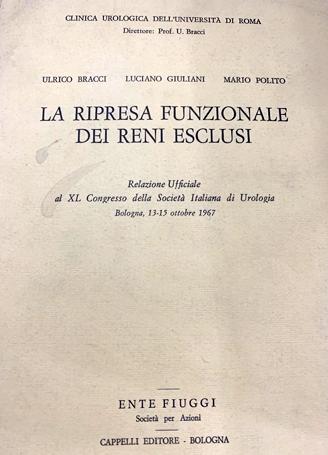
Giuliani, together with his mentor, played a central role in both the anatomo-surgical study and the writing of the text, with the collaboration of Prof Costantini and Prof Tacciuoli
These were fundamental years for Giuliani and constituted the foundations on which he would later build his long and fruitful academic pathway in the field of urology
These were precisely crucial years for Giuliani, as is demonstrated by his “prizes for scientific diligence” They were also very productive years for Prof Bracci's whole team, of which Giuliani was a member, both from the clinical and scientific standpoints and from that of the promotion of the discipline of urology Indeed, it was in those years that Italian urology laid down the foundations for the use of:
THE GREAT LEAP FORWARD: GIULIANI IN GENOA
The experience gained by Giuliani during the fruitful years in which he worked alongside his mentor Prof Bracci in Rome, summed to his tireless activity during the previous Florentine period, enabled him to reach such a level of maturity as to warrant his autonomous direction of a clinic The opportunity soon materialised – at one of Europe's largest hospitals of the day: San Martino Hospital in Genoa
Indeed, in 1969, the Department of Urology of San Martino Hospital was divided into two large branches:
- 1st Urology Division, headed by Prof Germinale, already tenured at San Martino Hospital;
- 2nd Urology Division, directed by Prof Giuliani
This was Giuliani's first fully autonomous position in which he had sole responsibility for direction At that time, he was working at the Urology Clinic in Rome as “University Vice-chief” to Prof Ulrico Bracci, and had already emerged as a “ternate winner” in a competition for professors
- A couple of years after being given responsibility for the Urology Division at San Martino, in March 1971, Giuliani was unanimously declared Extraordinary Professor of Urology at the Faculty of Medicine and Surgery of the University of Genoa; thus, he became the first tenured professor of the Chair of Urology in Genoa and in Liguria
The 2nd Urology Division was thus renamed “Urology Clinic” and, over the years, Genoa became the capital of Italian urology
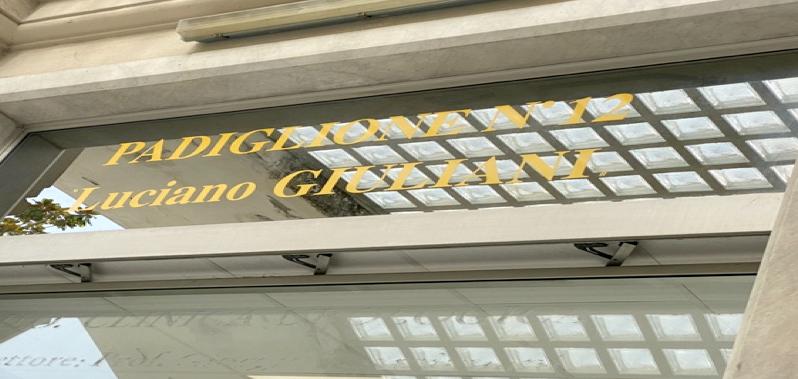
A short time later, in 1972, the Specialty School in Urology was also instituted at the University of Genoa, and was immediately entrusted to the direction of Prof Giuliani
Prof Giuliani was endowed with great intelligence and competence and possessed extraordinary surgical skills that enabled him to develop innovative, ground-breaking techniques Naturally enough, he rapidly emerged on the national and inter national scientific scene, distinguishing himself through his forceful personality and great authoritativeness Thus, he imparted an enormous thrust to the Genoese urology school, which soon became a point of reference for the scientific sector nationwide
In 1973, Giuliani was appointed President of the 46th National Congress of the Italian Society of Urology, which was held in Genoa A few years later (1978) he was elected President of the Italian Society of Urology (SIU), a post he held until 1982, when he was elected to the Executive Committee of the European Society of Urology (ESU)
The year 1986 was an important one not only for the Genoese School of Urology, the city of Genoa and the Liguria region, but also for the whole of Italian urology Indeed, it was in that year that Giuliani succeeded in founding and inaugurating the Centre for Calculosis of the Genoese Urology Clinic He equipped this facility with an extracorporeal lithotriptor (a very moder n apparatus that shattered calculi by means of an extracorporeal approach); a truly extraordinary event, since this was the first public facility in Italy to be so equipped!
Moreover, the “Genoese school” , directed by Prof Giuliani and featuring a team made up of Belgrano, Carmignani, Giberti, Martorana, Puppo et al , also distinguished itself through the production of a sort of “graphic-editorial exercise” in urological surger y, which was designed to aid and improve teaching activities
Indeed, 1986 saw the publication of a complete “Atlas of surgery of kidney cancer ” , probably the first such atlas in the history of Italian publishing; it was subsequently translated into English and distributed inter nationally
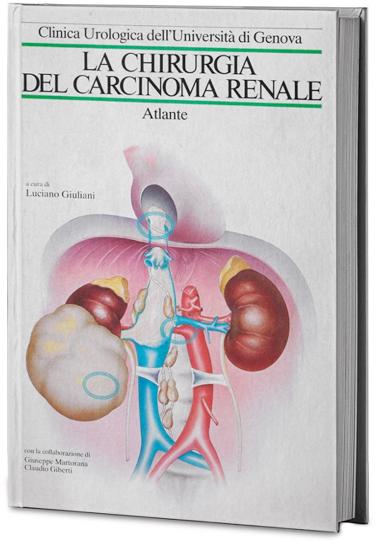
The Atlas provided an analytical and highly detailed presentation – in a rational, schematic and realistic form (as far as this was possible in an atlas of surgical techniques) – of the times and sequences most characteristic of the principal operations involved in the surgical treatment of kidney cancer (Figure 8)
And a couple of years earlier, on the occasion of the National Congress of Urology, held in Bari in 1984, a scientific text was published for the Proceedings of the Italian Society of Urology (SIU) under the title: “Pathways of access in urology” , a volume featuring ample drawings (16-19)
In 1988, with the retirement of Prof Germinale, and after a brief interim period of direction by another Ligurian colleague, the Urology Division was merged with the Urology Clinic and Giuliani became responsible for the single facility, which was very extensive and equipped with numerous beds (20)
This newly instituted single facility was a truly evocative retur n to the past, in that it brought urology back to the original structure directed by the great master Giorgio Nicolich Jr, which extended for almost 30 years, from 1938 to 1966 (21)
In April 1992, Giuliani succeeded in an enterprise that was, at that time, truly extraordinary and titanic: the inauguration of the new Genoese Urology Clinic (Figure 9)!
The entire operation was personally drawn up and directly supervised by Giuliani himself, with considerable financial support from the Genoese banking institution Ca Ri Ge Thus, Prof Giuliani achieved his objective of constructing an imposing, modern, complete facility consisting of: - a 4-storey building equipped with 80 beds;
- a semi-intensive post-operative therapy department;
- a surgical block devoted exclusively to urology;
- a centre for calculosis;
- a centre for urodynamics;
- an outpatient clinic;
- a teaching centre
Conclusions
During the Congress of the European Society of Urology in Berlin in July 1994, Prof Giuliani was awarded the highly prestigious Willy Grégoir Medal, an accolade conferred upon eminent personalities in European urology
A month later, on 18 August 1994, following a brief illness, Giuliani died in the very Institute that he himself had created in Genoa; he was 66 years old
In December of the same year, the Institute was named in his honour, thus becoming the “Luciano Giuliani Institute of Clinical Urology”
Luciano Giuliani was a distinguished scientist and one of the most renowned scholars of urology in the inter national scientific firmament Nicknamed “Grand Master” , Giuliani struck very deep roots and ploughed a furrow that ran uninterruptedly through the generations of his pupils, who were truly numerous and of high quality When faced with a clinical problem, every urologist should remember that things are what they are today because in the past there have been people like the Maestro Giuliani and clinical experiences that have, thanks also to advances in technology, pharmacology and biomaterials, allowed constant evolution, thereby enabling us to achieve ever-better results (da prefazione di Marco Carini) (13)
Acknowledgements
- Thanks to Prof Carlo Terrone (University of Genoa) for the photo number 9 and for reading the text
- Thanks to Gianmaria Martini (independent scholar) for the help in bibliographic data
References
1 Private Archive “Luciano Giuliani”
2 Circular N° 360 of G M 1951 Military School of Health, Florence
3 Military School of Health, Florence D M N° 2598/C of prot Doc of 13 October 1953, Prof Col G Piazza (Giuliani Private Archive)
4 Giuliani L L’ ibernazione G Med Milit 1953; 103:335-344
5 University of Pisa Certificate N° 3211, Matriculation N° 7/259
6 Rector's Decree N° 2544 of 18 November, 1957 (Official Bulletin of the Ministry of Education, Part II, N° 36 of 4 September, 1958, p 5048
7 Giuliani L Sulle vie biliari extraepatiche (nota anatomica) La Chirurgia Generale 1954; 3:189-207
8 Fedeli F University of Florence Institute of General Clinical Surgery and Surgical Therapy Florence, 6 June 1959
9 Rector's Decree N° 2544 of 18 November, 1957 (Official Bulletin of the Ministry of Education, Part II, N° 36 of 4 September, 1958, p 5048
10 Giuliani L La gastrocistoplastica: dall'idea sperimentale ad alcune considerazioni pratiche in tema di chirurgia plastica e sostitutiva della vescica Urologia 1958; 25 (suppl 7)
11 Giuliani L, Pisani E L'intestino nella chirurgia plastica e sostitutiva della vescica: valutazione cistografica e cistomanometrica dei risultati Arch It Urol 1959; 32:164
12 Luciano Giuliani Private Archive
13 Martorana G L’uso dell’intestino in urologia (The use of the intestine in urology) Bononia University Press Bologna, 2021
14 Bracci U, Giuliani L, Costantini A, Tacciuoli M The Surgical Treatment of Prostate Cancer Vallecchi ed Officine Grafiche Firenze, 1961
15 Bracci U, Giuliani L, Polito M La ripresa funzionale dei reni esclusi (The functional recovery of excluded kidneys) Relazione ufficiale al congresso della Società Italiana di Urologia, Capelli ed Bologna, 1967
16 Bracci U Le vie d’accesso nella chirurgia dell’apparato urinario Le vie d’accesso al rene Macrì, Firenze, 1956
17 Giuliani L, Carmignani G, Belgrano E, Martorana G Le vie d’accesso in chirurgia urologica Relazione ufficiale LVI Congresso, SILI, Bari, 3-6 ottobre 1984
18 Giuliani L, Giberti C, Martorana G Atlas of surgery for renal cancer 2nd ed Zambeletti S p A , Milano, 1989
19 Giuliani L, Giberti C, Martorana G, Rovida S Radical extensive surgery for renal cell carcinoma: long-term results and prognostic factors J Urol 1990; 143:468 5
20 Malinaric R, Mantica G, Martini M, et al The Lifetime History of the First Italian Public Extra-Corporeal Shock Wave Lithotripsy (ESWL) Lithotripter as a Mirror of the Evolution of Endourology over the Last Decade Int J Environ Res Public Health 2023; 20:4127
21 Carmignani G, Traverso P (Durand F) Brief history of Ligurian urology Tipografia Araldica Genova, 1997
Correspondence
Mariano Martini, MD, PhD (Corresponding Author) mariano martini@unige it mariano yy@gmail
Department of Health Sciences, University of Genoa
Largo R Benzi 10, 16132 Genoa, Italy
Giuseppe Martorana, MD
University of Bologna, Bologna, Italy
Conflict of interest: The authors declare no potential conflict of interest





